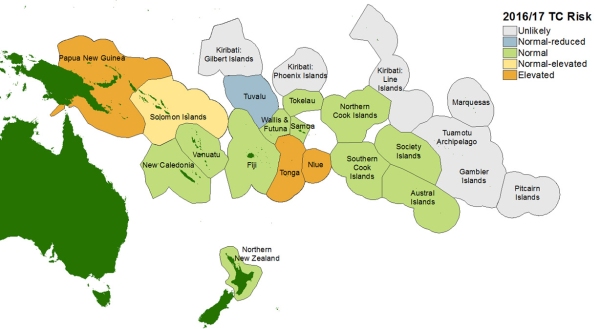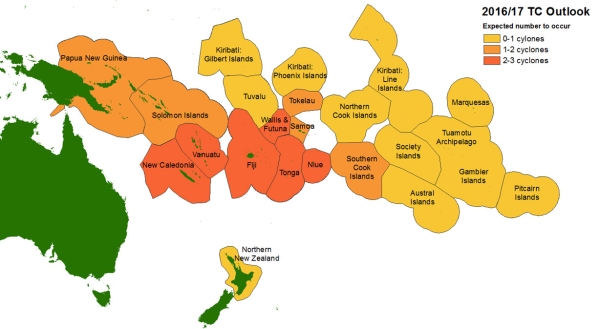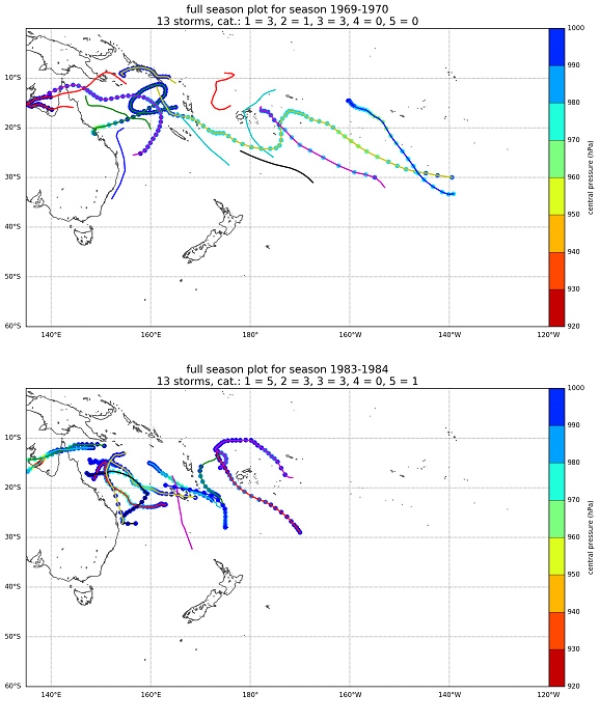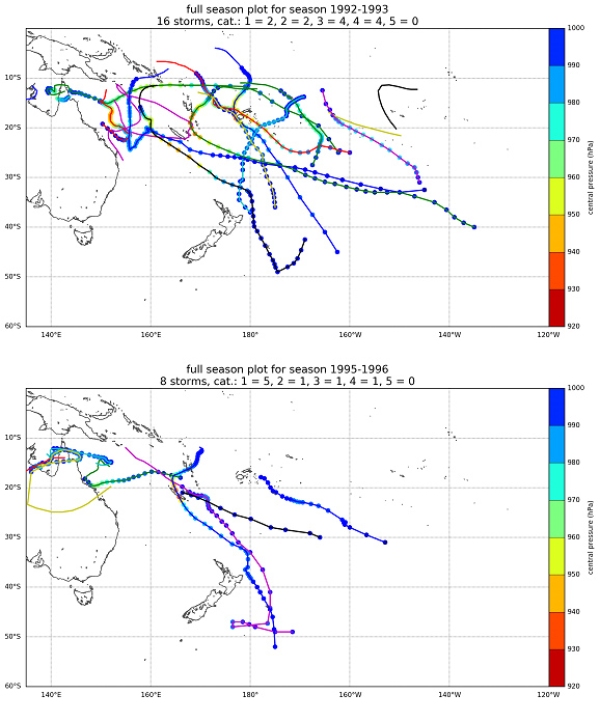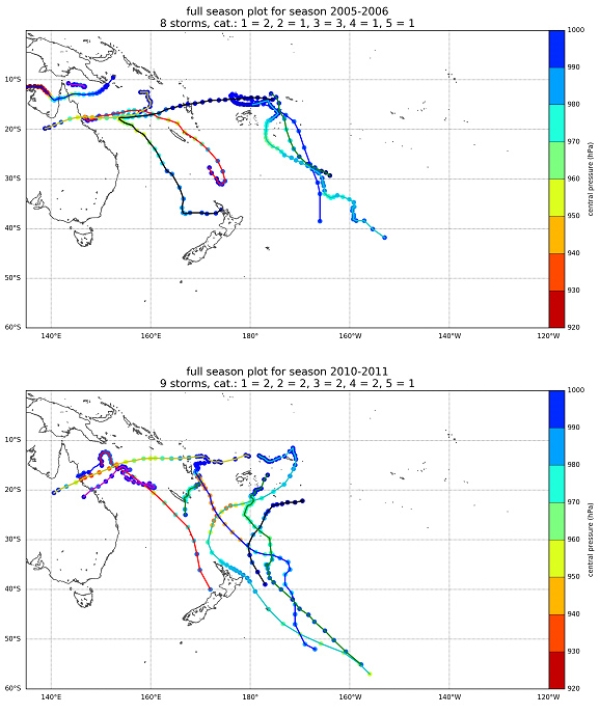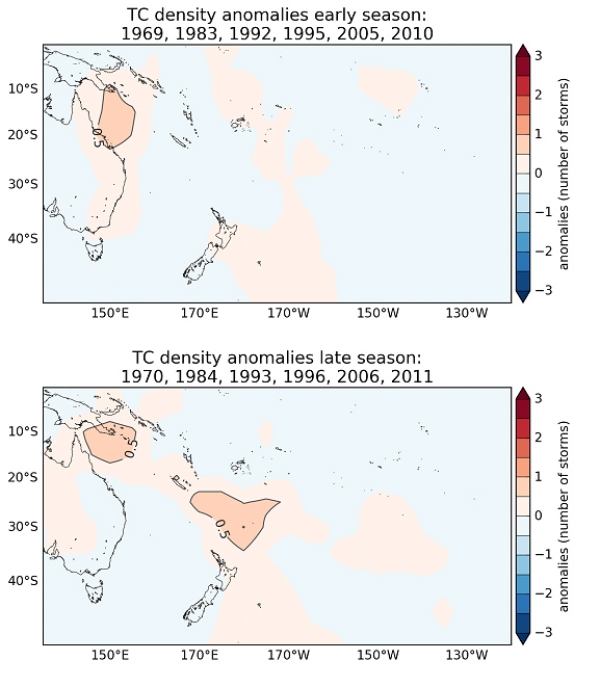Moderate La Niña or neutral tropical conditions expected to produce near average activity across most islands.
Meteorological and climate analysis centres across the Southwest Pacific are indicating near average numbers of tropical cyclones (TC) for the 2016–17 season (November 2016 to April 2017). The 30-year average number of all Southwest Pacific tropical storms that formed between 1981-2010 is 12.4 for the November and April TC season.
Climate scientist Nava Fedaeff explains the South Pacific tropical cyclone outlook for the November to April period.
The average number of storms that developed into named TCs (Category 1 or stronger) during the same interval is 10.4 for the SW Pacific basin (between 135°E - mid-Gulf of Carpentaria and 120°W - French Polynesia).
The outlook indicates that 8 to 10 named TCs are expected for the coming season. TC activity is elevated for the Pacific Island countries to the north of the Coral Sea and close to the International Date Line near Tonga and Niue.
It should be recognised that the six-month outlook reflects an expectation of overall elevated activity during both the early season (November to January) and the late season (February to April) particularly west of the Dateline. Note that the TC activity outlook for islands like New Caledonia, Fiji, Vanuatu and Tonga indicates two or more cyclones could interact with each of those countries during the season despite subtle projected differences from normal. At least 5-6 severe TCs (Category 3 or higher) are expected to occur anywhere across the Southwest Pacific during the season. All communities should remain vigilant and follow forecast information provided by their national meteorological service.
On average, New Zealand experiences at least one ex-tropical cyclone passing within 550km of the country every year. For the coming TC season, the risk for New Zealand is near normal. If an ex-tropical cyclone comes close to the country, the current background climate conditions suggest it has a greater probability of passing east of Auckland and the North Island. Significant rainfall, damaging winds and coastal impacts can occur leading up to and during these episodic events.
Outlook analysis
Ocean and atmosphere forecasts for ENSO indicate weak-to-moderate La Niña or neutral conditions are most likely for summer. Presently, sea surface temperature anomalies across the central and eastern Equatorial Pacific Ocean and the atmospheric circulation patterns over French Polynesia and northern Australia indicate conditions are close to neutral but leaning toward La Niña. Taking this climate outlook scenario into account, normal TC activity can be expected for most islands in the Southwest Pacific, with 8 to 10 named TCs forming across the region during the November 2016–April 2017 period. Despite the outlook for mostly normal conditions for this season, southwest Pacific islands fringing the north Coral Sea, including Papua New Guinea and the Solomon Islands and those nations situated adjacent to and east of the International Date Line including Tonga and Niue (and to the south of those nations) may experience slightly elevated activity. Reduced risk is expected for Tuvalu.
Southwest Pacific TCs are grouped into classes ranging from 1 to 5, with 5 being the most dangerous. For the coming TC season, at least six storms are anticipated to reach at least Category 3, with mean wind speeds of at least 64 knots or 118 km/h (so-called ‘hurricane force’ winds). Of those systems, four storms may reach at least Category 4 strength, with mean wind speeds of at least 86 knots or 159 km/h. In addition, Category 5 strength TCs (winds greater than 106 knots or 196 km/h) are known to occur during seasons like the current one. Therefore, all communities should remain alert and well prepared for severe events.
Tropical cyclones have a significant impact across the Southwest Pacific from year to year. Vanuatu and New Caledonia typically experience the greatest activity, with an average of 2 or 3 TCs passing close to land each year. On average, New Zealand usually experiences at least one interaction per season with an ex-tropical cyclone. Some of the analog seasons identified for this outlook show multiple ex-tropical cyclones coming close (within 550 km) to the country. Significant wind, waves and rainfall are possible from these systems. Their effects can be spread over a larger area when the ex-tropical cyclone interacts with separate weather systems.
Even though TC activity is expected to be relatively low for some countries, historical cyclone tracks (see supporting information for this outlook, Figure 3) indicate that TCs can affect all parts of the SW Pacific region. As with most years, activity is expected to increase during the late part of the TC season from February-April.
All Pacific Islands should remain vigilant in case conditions in the equatorial Pacific change during the TC season. Past analog seasons that started similar to the present have seen intensification to well-coupled La Niña conditions and increased activity west of the Dateline in the late season. NIWA will continue to track the progression of ENSO and update the guidance in January if needed.
New Zealand’s National Institute of Water & Atmospheric Research (NIWA) and Meteorological Service of New Zealand (MetService) along with meteorological forecasting organizations from the Southwest Pacific, including the Australian Bureau of Meteorology, MeteoFrance and the Pacific Island National Meteorological Services have prepared this tropical cyclone outlook.
Contacts
In New Zealand:
Mr. Chris Brandolino Principal Scientist - Forecasting, NIWA
Mr. Chris Noble Manager, Specialist Weather Services MetService New Zealand
Mrs. Elke Louw Wellington RSMC (Regional Specialized Meteorological Centre) Manager, Marine Weather Services MetService New Zealand
Dr. Andrew Lorrey Climate Scientist, NIWA
Dr. Nicolas Fauchereau Climate Scientist, NIWA
In the Pacific Islands, please contact your local national meteorological service for information about how this guidance should be interpreted.
For Australia and associated offshore islands, please contact the Australian Bureau of Meteorology for information about how this guidance should be interpreted.
For French Polynesia, Wallis, Futuna and New Caledonia, please contact MeteoFrance regional offices for information about how this guidance should be interpreted.
Additional background information
TCs in the Southwest Pacific usually develop between November and April, but occasionally they can occur in October and May, very rarely in June, July and August and relatively unknown in September.
Peak TC season is usually from January to March. In seasons with similar background climate conditions to present, TC activity was slightly elevated west of the International Dateline and over the northern Coral Sea. In addition, the strongest TC anomalies were focused in the region between Papua New Guinea and the Solomon Islands, which is associated with a southwest displacement of the South Pacific Convergence Zone (SPCZ) during La Niña events. There is also a region of increased TC incidence south of Tonga and Niue and to the north of the North Island. On average, nearly half of the TCs that developed since the 1969-70 season have reached hurricane force with mean wind speeds of at least 64 knots (118 km/h).
To find past analogs that describe the climate state leading into the upcoming TC season, the past May-September conditions were examined for the tropical Pacific from 1969 to the present. For the majority of winter and early spring 2016, the ENSO system deteriorated from a well-coupled El Niño to an ocean-dominated El Niño state, then reached neutral conditions (slightly leaning toward La Niña). Available information from international forecasting centres that issue global climate forecast model outputs and ENSO diagnostics are discussed by the international climate research community that and these are integrated by NIWA’s National Climate Centre. The collective guidance suggests El Niño is not likely, and a weak La Niña event is expected develop. As such, an additional element used to select the TC analog seasons included tracks that occurred when some form of moderate La Niña or ENSO neutral conditions continued from spring into austral summer.
We used a joint ENSO index that combines the Southern Oscillation Index (SOI) with the most widely-used oceanic index of sea surface temperature anomalies in the equatorial central-western Pacific (NINO3.4). This joint ENSO index is described in Gergis and Fowler (2005) as the “Coupled ENSO Index” (CEI). Using the CEI, we selected analog TC seasons for the 2015-16 forecast. We highlighted seasons when the equatorial SSTs and the SOI were strongly indicative of El Niño (as defined by the CEI with a 5-month mean SSTa threshold greater than + 0.5°C and an 3-month SOI threshold below - 1.0) during the May-September pre-TC season interval.
Six analog TC seasons (1969/70; 1983/84; 1992/93; 1995/96; 2005/06; 2010/11) typified the antecedent ENSO development and our expectations for the coming season based on international ENSO forecasts. Note that the small number of analog seasons relates to the high-quality TC data period in the satellite era beginning in 1969/70 (only 46 seasons), the availability of TC track data (current only to the end of the 2015/16 season), and the limited number of similar analogs to this season. As such, the tropical cyclone guidance for November 2016 to April 2017 is built on the six analog seasons identified above.
NIWA’s SW Pacific TC outlook spans four areas of responsibility overseen by international monitoring and forecast agencies (RMSC Nadi, TCWC Brisbane, TCWC Port Moresby and TCWC Wellington). We used a high quality set of past TC tracks from the South Pacific Enhanced Archive of Tropical Cyclones (SPEArTC) (Diamond et al., 2012) which covers 135°E to 120°W longitude to draw on past TC track patterns for this seasonal outlook. This region encompases a basin that is defined by climatology rather than geopolitical or meteorological boundaries (Diamond et al., 2012). The analog tracks and anomalies for this region suggests TC activity is likely to be close to normal for many island nations this season. However, southwest Pacific islands fringing the north Coral Sea, including Papua New Guinea and the Solomon Islands and those nations situated adjacent to and east of the International Date Line including Tonga and Niue (and to the south of those nations) are expected to see slightly elevated activity (Table 1; Figure 2 & 3). Tuvalu is expected to experience normal or below normal activity for a TC interaction. The main TC genesis region is expected to lie within a band between 10 – 12°S (between Vanuatu and Fiji) west of the International Date Line. There is a reduced likelihood of multiple Category 4 or 5 systems occurring this season based on the selected analogs, but we recognise one analog season experienced four Category 4 tropical cyclones. A total of 9 named storms on average are expected; the range of variation between analog seasons suggests 8 to 10 for the total TC count (all named storms) within the TC outlook area could occur, which is close to normal.
Recent research has indicated TC track sinuosity is moderate during ENSO neutral conditions and reduces more so during La Niñas (Philip Malsale, Vanuatu Meteorological Service, personal communication). This means that weaker TCs, such as a Category 1 or 2 systems, may have more linear tracks than normal. Past tracks for years similar to the present had a tendency to cover a zone ranging from a genesis region north of Fiji and Vanuatu ETT usually occurs near Tonga (mean longitude of ~172°W and a heading of ~135° at 25°S). For the historical TC tracks for the selected analog seasons, there is a very large spread for the location where each system underwent ETT that presents significant uncertainties for maritime navigation risks.
A split of the analog TC seasons into early (November – January) and late (February – April) periods suggests TC activity will be close to normal during both parts of the TC season across the SW Pacific basin as a whole (Figure 4), with the exception of elevated activity in the north Coral Sea and also elevated activity in the late season northeast of the North Island. A change in the foci of TC activity is also apparent as the season progresses (particularly for islands identified adjacent and to the east of the Date Line). Activity is expected to increase near French Polynesia as the season progresses .
TC intensity is related to how long developing cyclonic systems reside in the deep tropics and feed on warm waters for their growth. In addition, the subtropical jet and South Pacific Convergence Zone (SPCZ) mutually interact and contribute to shear during extra-tropical transition. It should also be noted that the interplay of a hemispheric-scale atmospheric circulation with the timing of the short-term Madden-Julian Oscillation (MJO) passage (typically on a 30-50 day cycle) has significant bearing on TC activity in the region. Increased and and more intense TC activity can be expected during the MJO 6-7 paired phase (Diamond and Renwick, 2015). Real-time monitoring of the MJO is available from the Australian Bureau of Meteorology.
Previous work (Lorrey et al., 2013) indicates New Zealand interacts with at least one ex-tropical cyclone passing within 550km of the country every year. For the coming TC season, the risk for New Zealand is near normal as a whole, but appears slightly above normal for the late season. If an ex-tropical cyclone passes close to the country, it has greater probability of passing east of Auckland city.
Weekly statistical forecasts of TC genesis and TC activity for the SW Pacific basin are produced by MeteoFrance based on phasing of the MJO (Leroy and Wheeler, 2008).
References
Gergis, J., and A. M. Fowler, 2005: Classification of synchronous oceanic and atmospheric El Niño–Southern Oscillation (ENSO) events for palaeoclimate reconstruction. International Journal of Climatology, 25, 1541–1565.
Diamond, H.J., and J.A. Renwick, 2015: The climatological relationship between tropical cyclones in the southwest Pacific and the Madden-Julian Oscillation. International Journal of Climatology, 35: 676-686. doi: 10.1002/joc.4012.
Diamond, H.J., A.M. Lorrey, K.R. Knapp, and D.H. Levinson. 2012. Development of an enhanced tropical cyclone tracks database for the southwest Pacific from 1840-2011. International Journal of Climatology, 32: 2240–2250. doi:10.1002/joc.2412.
Diamond, H.J., A.M. Lorrey, and J.A. Renwick. 2013. A Southwest Pacific Tropical Cyclone
Climatology and Linkages to the El Niño–Southern Oscillation. Journal of Climate, 26(1), 3-25. doi:10.1175/JCLI-D-12-00077.1.
Leroy, A. and Wheeler, M.C. 2008. Statistical Prediction of weekly tropical cyclone activity in the Southern Hemisphere. Monthly Weather Review, 136, 3637-3654.
Lorrey, A.M., G. Griffiths, N. Fauchereau, H.J. Diamond, P.R. Chappell, and J. Renwick, 2013. An ex-tropical cyclone climatology for Auckland, New Zealand. International Journal of Climatology, doi: 10.1002/joc.3753.
Table 1: The following table gives the average number of TCs passing close to the main South Pacific Island groups between November and April. The activity associated with some island groups for the coming season is a subjective assessment, and has been stated to be consistent with the wishes of the national meteorological services involved in generating this regional forecast. In addition, subjective qualification of activity (and associated risk) also recognises the small differences between the actual TC counts for the analog composites and climatological values. The table is therefore only generally indicative of how many storms might be expected for any given island group for the coming season.
|
Country/ |
Climatology |
Analog seasons |
Anomaly |
% Difference |
Risk |
|
Territory |
|
|
|
|
|
|
New Caledonia |
2.75 |
3 |
0.25 |
25 |
Normal |
|
Tonga |
2.2 |
2.7 |
0.5 |
50 |
Elevated |
|
Niue |
1.8 |
2.5 |
0.7 |
70 |
Elevated |
|
Fiji |
2.5 |
2.5 |
0 |
0 |
Normal |
|
Vanuatu |
2.9 |
2.5 |
0.4 |
-40 |
Normal |
|
Wallis & Futuna |
2.2 |
2.2 |
0 |
0 |
Normal |
|
Papua New Guinea |
0.9 |
1.5 |
0.6 |
60 |
Elevated |
|
Solomon Is. |
1.2 |
1.5 |
0.3 |
30 |
Normal-elevated |
|
Samoa |
1.7 |
1.5 |
-0.2 |
-20 |
Normal |
|
Tokelau |
1.6 |
1.3 |
-0.3 |
-30 |
Normal |
|
S. Cooks |
1.3 |
1.2 |
-0.1 |
-10 |
Normal |
|
Tuvalu |
1.4 |
1 |
-0.4 |
-40 |
Normal-reduced |
|
N. New Zealand |
0.75 |
0.75 |
0 |
0 |
Normal |
|
W. Kiribati |
0.1 |
0.6 |
0.5 |
- |
Unlikely |
|
Society Is. |
0.7 |
0.6 |
-0.1 |
-10 |
Normal |
|
N. Cooks |
0.5 |
0.5 |
0 |
0 |
Normal |
|
Austral Is. |
0.75 |
0.5 |
-0.25 |
-25 |
Normal |
|
Tuamotu |
0.2 |
0.1 |
-0.1 |
- |
Unlikely |
|
Pitcairn |
0 |
0 |
0 |
- |
Unlikely |
|
E. Kiribati |
0 |
0 |
0 |
- |
Unlikely |
|
Marquesas |
0.1 |
0 |
0 |
- |
Unlikely |
Table 2: The following table gives analog seasons and intensity of TCs and storms that occurred in the Southwest Pacific.
|
Season |
Number of named storms |
Right: TC category (BoM scale) |
Cat 1 |
Cat 2 |
Cat 3 |
Cat 4 |
Cat 5 |
|
1969/70 |
7 |
3 |
1 |
3 |
0 |
0 |
|
|
1983/84 |
12 |
5 |
3 |
3 |
0 |
1 |
|
|
1992/93 |
12 |
2 |
2 |
4 |
4 |
0 |
|
|
1995/96 |
8 |
5 |
1 |
1 |
1 |
0 |
|
|
2005/06 |
8 |
2 |
1 |
3 |
1 |
1 |
|
|
2010/11 |
9 |
2 |
2 |
2 |
2 |
1 |
|
|
Mean total |
9.3 |
3.2 |
1.7 |
2.7 |
1.3 |
0.5 |
|
|
Rounded mean total |
10 |
3 |
2 |
3 |
1 |
1 |
Analog guidance summary
Based on the guidance NIWA has generated, 8-10 named TCs are expected for the 2016-17 season for the Southwest Pacific basin (135° E – 120° W). The spread for the estimated storm activity comes from the variation between selected analog seasons. The historic average is just over 10 named cyclones per season for the basin, indicating near normal or slightly below normal activity for this coming season across the SW Pacific islands.
Potentially, a combination of up to five cyclones may reach category 3 or 4 status. The long term TC climatology (last 45 seasons) and the analogs we have identified suggests the occurrence of a Category 5 system is 50% likely for this season with respect to historic observations. All of the historic analogs selected for the 2016-17 outlook indicate multiple severe TCs equivalent or greater than Category 3 occurred in seasons similar to present. This lends a moderate-to-high degree of confidence in the outlook for storm strength.
For the selected analogs, some years show two ex-tropical cyclones came within 550 km of New Zealand while others show one or none. The average interaction is one named storm. Some of these storms made landfall, with a majority of interactions during the latter half of the TC season (February-April). Some of the systems were also associated with high rainfall, damaging winds and amplified coastal wave conditions. There risk of an interaction for New Zealand (at least one storm coming within 550km of the country) for the 2016-17 season is close to normal. The probability of a cyclone tracking to the east of the North Island appears to be higher than normal.

